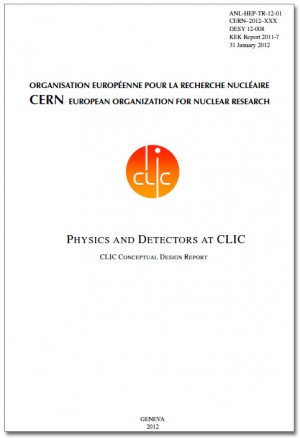
CLIC Physics and Detector Conceptual Design Report (CDR) was completed in December 2011. Image: CLIC
Finally – finally we start to see results from CERN’s Large Hadron Collider (LHC) that can provide guidance towards a linear collider implementation. It is too early to be conclusive, and more data is definitely needed, but we can be optimistic and excited about 2012. The LHC experiments are zooming in on a low energy Standard Model-like Higgs and by the end of 2012 much more precise results can be expected concerning this possibility, provided the machine can deliver the luminosities promised. In December the LHC’s ATLAS and CMS experiments reported their Higgs analyses status at CERN. The reactions and interpretations were mixed, but everybody was impressed by how quickly and comprehensively the data had been examined.
At the same time we know that the LHC experiments continue to search for signatures of Beyond Standard Model physics, for example supersymmetric models and other high-energy phenomena. We also know that many of these phenomena can be thoroughly studied at a linear collider (LC) and they provide a significant part of the LC physics case. In this area we presumably still have to be patient, as only after its long shutdown in 2013-14 will the LHC reach its full energy and be able to push the SUSY limits and discovery potential fully. However, maybe we can be lucky already in 2012; sometimes it does not hurt to be optimistic. In any scenario, the LHC is now really starting to guide the way, as we have all hoped for.
Are we prepared? Technically, probably yes. The ILC technology is well developed – the Technical Design Report (TDR) is under way. The CLIC technology is also moving rapidly forward – a Conceptual Design Report (CDR) is being completed these days, though it is less mature than the ILC technology. The detector studies are, in my view, well developed. If one compares to the extrapolation in performance one had to make and plan for during the LHC detector construction period, the LC detectors are well advanced and many of the functional parameters are being demonstrated. We also know the key technologies continue to make progress and that many of these technologies can be fully exploited in an LC detector where the radiation levels are more modest than at LHC.
Another milestone in December from my perspective was the completion of the CLIC Physics and Detector Conceptual Design Report. The feasibility of making detailed measurements up to 3 TeV, with the demanding beam time structure of CLIC, is well demonstrated. Most other cases are likely easier. The work and document was reviewed by external experts in October and presented to the CERN Scientific Policy Committee in December by Lucie Linssen. This work is an excellent example of a common LC effort where physicists with ILC and/or CLIC main interests have worked together very efficiently. It was well received, with the main comments emphasising the need for a machine implementation that allows operation at a wide range of energies and that can be adapted to the physics landscape emerging from LHC running. The accelerator volume of the CDR is also under way and will be presented to the same committee in March 2012, including recent measurements in the CLIC test facility at CERN. One can now also sign up to support the studies presented in the CLIC CDR.
Do we have the processes in place that make a linear collider a reality? Not fully, but we are making progress. If one asks physicists around the globe what the timescale, site, and technical implementation of the optimal machine are, one will get different answers. The answers reflect regional views as well as views and hopes of which physics may be within reach. So indeed, more physics guidance will make these choices much easier. Setting up a global LC organisation, involving the entire community, with clear and unique communication lines between the accelerator studies and detector and physics communities is mandatory. The organisations today for ILC and CLIC, including many common working groups, have served us well for the CDR and TDR phases, but now is the time to think ahead. Again there are different views, as there should be, but I hope and believe a common way forward can be found. Important progress was made during the International Linear Collider Steering Committee (ILCSC) meeting in Mumbai in August 2011, and the forthcoming ILCSC meeting in Oxford will be important to continue this process.
In every region there are roadmap processes planned or under way. In Europe the so-called European Strategy Update process will take place this summer and autumn and conclude in early 2013, and I have recently followed a Physics Department Faculty meeting at CERN where the process was outlined in more detail. A large fraction of the same meeting was used to discuss LC matters, with a particular focus on the CLIC detector and physics studies recently concluded. The need to present the case for a LC that can complement and provide significant improved physics results compared to those that can be expected from a luminosity-upgraded LHC was repeatedly mentioned. This is clearly the challenge we have to rise to, and we should be able to provide such answers. Again, this challenge will be significantly easier if early LHC running can provide more guidance of what models to concentrate on, but in absence of this we can demonstrate the same for a representative set of possible models. It will be another busy year.


Recent Comments